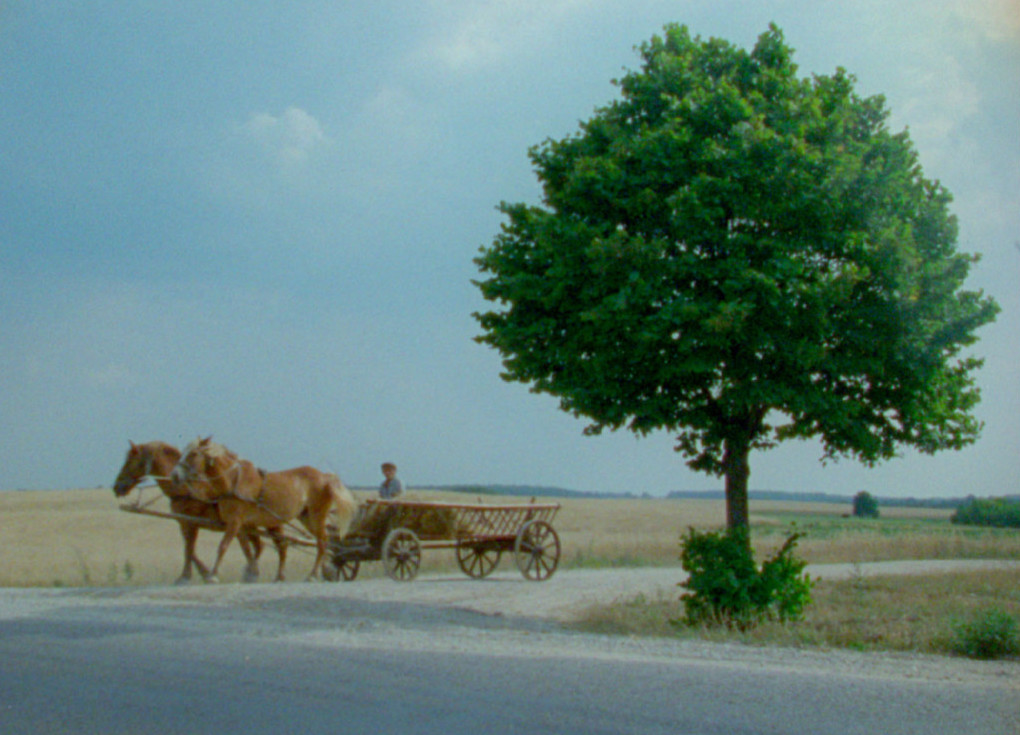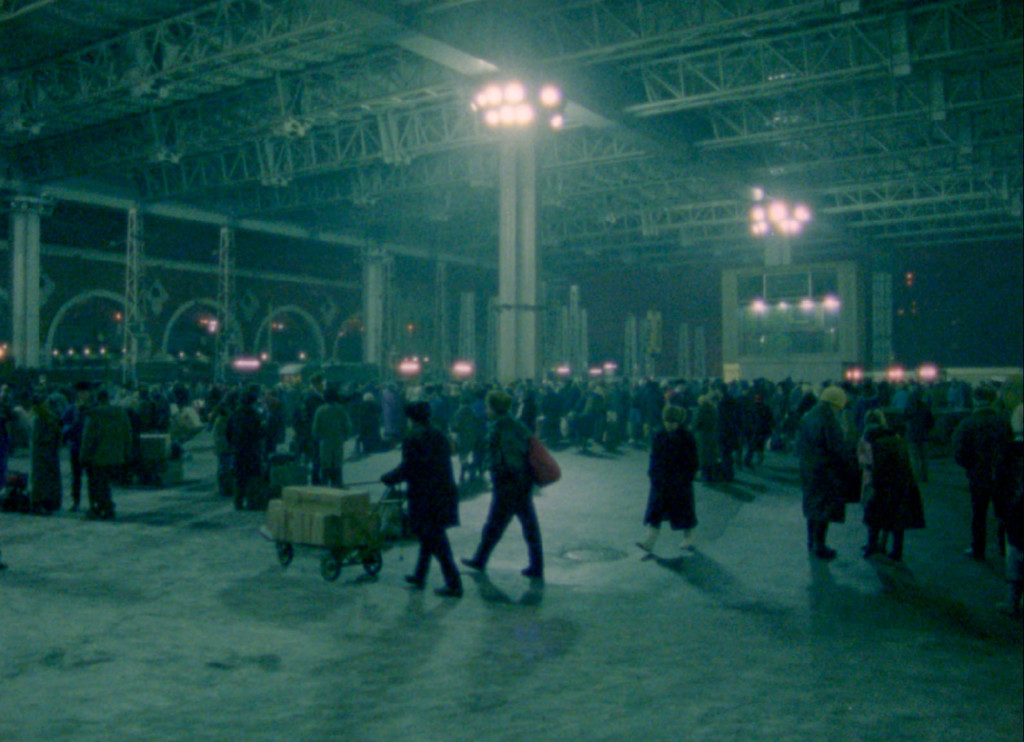Obstinately from a Single Point of View
About D’Est by Chantal Akerman

D’Est – a film, a video installation. Between cinema and museum, between projection in time and distribution in space, between celluloid and electronic image. But also between two cultures, that of film and that of visual arts – between two ways of asking the question of the image: in film the question of the right image, in the museum the question of the impossible depiction.
Not a documentary about Eastern Europe (the realistic option). Not an “experiment” about film (the avant-garde option). Akerman’s concerns do not grow from formal working hypotheses, nor from the question of information. She is not led like a reporter by the real as information, nor by theory that questions the image. She is guided by concrete, ethical questions about the value and duties of images. For her, images are neither concepts nor passive casts, but relationships.
After all, film images are always the answer to a question posed by the previous image but also formulated during the filming by the maker: “What is this?” The film image replies; it is the echo of the question. This means that every film image depends on that question, owes its existence to it, is subordinate and subject to it. Akerman wants to free her images from the spell of the question. They do not have to answer; she is not subjecting them to an examination.
Her images are made as if there was not a question first, but that image. The question inevitably comes to the viewer afterwards – and too late. Her images appear as inscrutable factuality. Sphinx images.
Akerman makes “images as facts” (not images of facts). We have to accept them as inescapable and without purpose. Her images are standing there. They are stripped of interpretation by their imperturbable length. As if Akerman waits so long to shout “cut” when filming and editing that no one manages to get out from under the spell of that mechanical duration. “Why end a shot?” is a question that becomes increasingly difficult to answer the longer the shot lasts, until her images become a wall, pouring out every ounce of their weight onto your retina.
We quickly realise how hard Akerman works at making images without an accent (the signature of an I) that would soften their weight or moderate their starkness. Discipline and relentless self-control – while filming the shots but also at the editing table. To avoid reacting impulsively, she has to be extremely alert to all stimuli from the field and resist their bombardment. Above all, she does not want to be a tourist, which means that she has to be able to see right through the anecdote, through the exotic. This succeeds only by watching for a long time, until their exoticism is burned up.
The granite factuality of each shot is facilitated by the montage, too. Images are not put together “facing each other” but tied up back to back. It is not an embrace in fluid continuity but emphatic repulsion. The images are not in dialogue with each other; they do not functionally complement each other. Each edit is a boundary between a preceding and a new image. Each shot acquires absolute autonomy. The shots do not tolerate interferences, interpretations, explanations of other shots. Akerman therefore devotes only one shot to each subject. Her films do not have an image sequence in which each shot, laden with information, steers the course. No, she films obstinately from a single point of view, and nothing else is told.
Here, one does not identify with something in the image but with the camera’s showing-watching, not with a sequence of images but with each image individually. To put it briefly, here images no longer have a function. The image has no purpose towards which it is unerringly directed by the montage, like a bomb achieving its goal in life by exploding. Instead, the images lie still: the spectator has to demine them while watching, answer their unresolved questions.
This creates the effect of a rear-view mirror: why that image? What is the position of the camera? And above all: what do the figures in the image see as they watch the bunch from the West agonisingly sounding them out? And: why this image after that previous one? (Not the curious “What will follow?” but the pensive “What was it again that came before?”) One passes through the film à reculons [backwards].
The spectator achieves a painful liberation from a “purpose” – the insight the filmmaker already has while filming and certainly while editing. Here, the neat story he wants to tell and the flow of information he knows exactly how to steer do not dominate the blocks of images and sound she presents us with. The meaning does not jeopardise the images.
You see that Akerman does not know what to think about that Far East of Europe, but she does know how she wants to make her images. Images tightly stretched in their frame, like a mounted canvas or a framed photograph. Tightly stretched and fixated, especially her already famous dolly shots along the waiting masses. Images that constantly seem to be exchanging their cinematic character for other, more photographic possibilities: those of the still. Images so obstinately sustained that – like a Richter – they blur and become increasingly abstract. Not literally, but in the spectator’s attention. Her images turn the film screen into a flat surface; the illusion of depth becomes porous, the primal gesture of projection tangible again.
The art world’s interest in Akerman is therefore understandable. There are indeed important points of contact: the film screen as a plane, the formalist sensibility, the provocatively cruel neutrality, her distrust of telling stories.
Nevertheless, any place for watching her work seem dangerous to me: the cinema as much as the museum or the television monitor. After all, her fundamental question as a filmmaker is an artisanal one: “What can I tell (not much of what I don’t understand after all) and how should I show (what I don’t understand)?” What she tells and shows is that there is something there. Obscure, massive and of a dull density. Her questions have to do with the investigation of this matter. Her questions circle around the correct relationship to what one does not understand. “Am I saying it correctly?” “Am I showing it just enough?” They have a legal dimension: “By what right?” And precisely because her statements are so few, she assumes unimaginable rights when listening. A search for the valid and responsible image today. For a human yet truthful image. For an image that forces the spectator to be free. Today, that search is not the question in the museum, not in television and not in cinema.
Akerman’s work is as simple and honest as it is intense and consistent. The way to it is not paved by an institution, nor by an industry. Everyone interested must, like Akerman, set out on their own and see if and in what way they can meet this great film.

Images from D’Est (Chantal Akerman, 1993)
This text originally appeared in Kunst & Cultuur, December 1995.
This translation was published by courtesy of Reinhilde Weyns and Bart Meuleman.
With the support of LUCA School of Arts, LUCA.breakoutproject.

